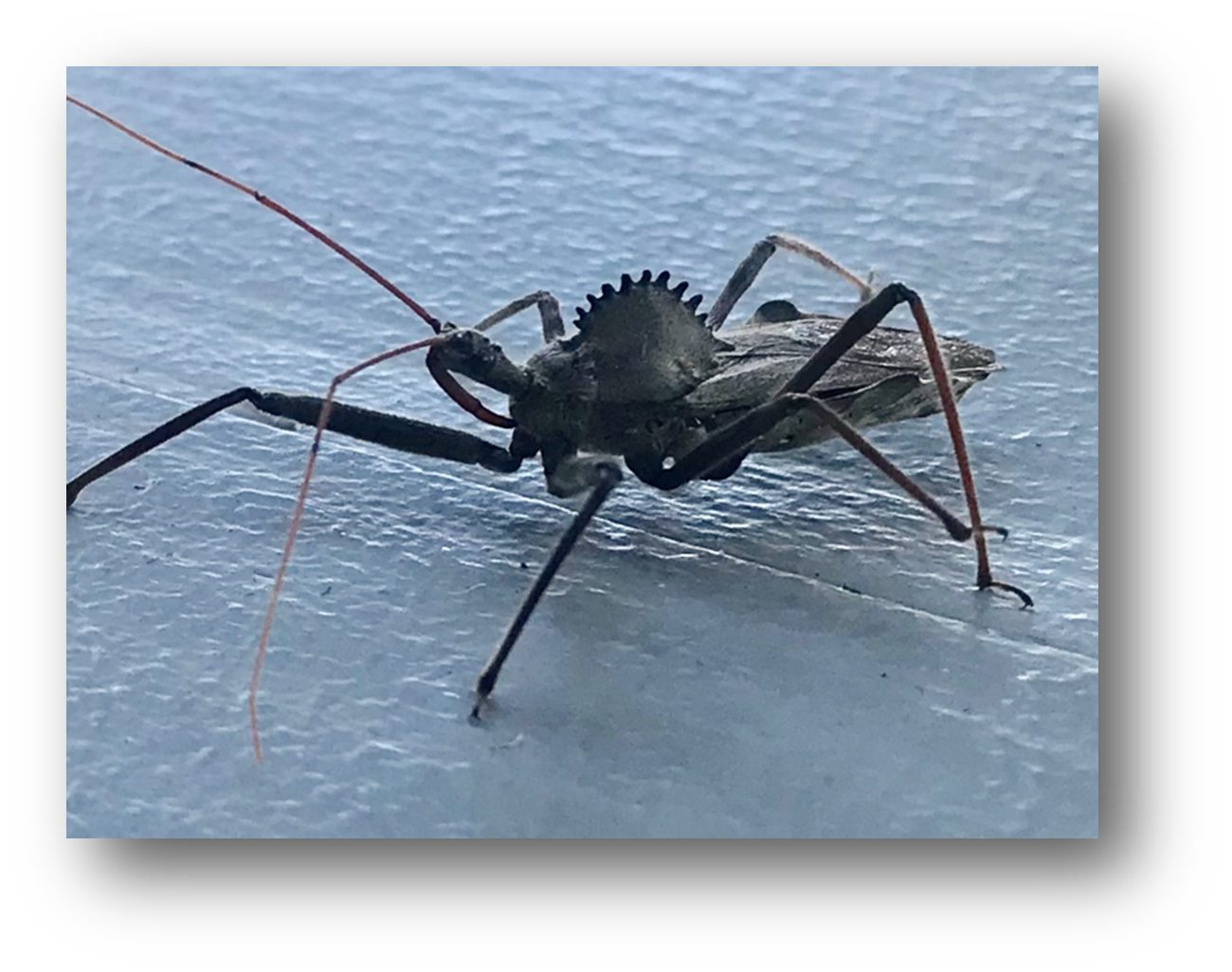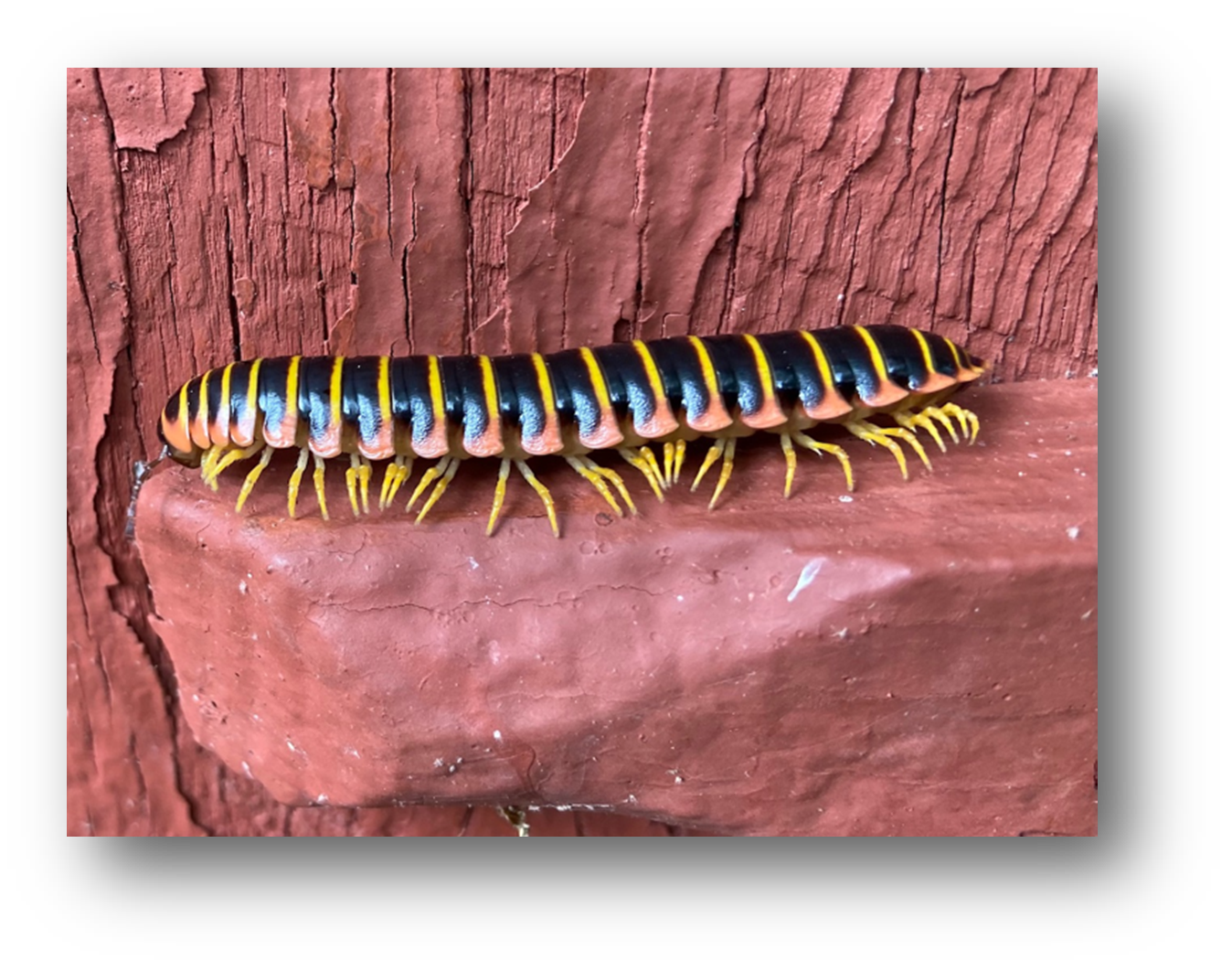
VIEW ON NATURE: Otherworldly...
By: Stephen L. Wendt
 Wheel bug is known for the "spokes"on its back and
Wheel bug is known for the "spokes"on its back and
is a member of what is collectively called assassin bugs
What’s over 2 inches long, has scores of always-moving yellow legs, and oozes a cyanide toxin that smells like cherries? Answer…the vibrantly colored cherry millipede.
The cherry millipede’s beautiful contrasting colors, color patterns, and body symmetry may be one of Nature’s finest works of art. Every time I come across one, I marvel at its shiny jet-black body of 19 segments individually framed in yellow on top and rose-orange on the sides propelled by two sets of dexterous lemon-yellow legs. It looks otherworldly as it flows flawlessly, mechanically over all surfaces. Seventy-six legs moving in perfect harmony.
I know, I know, it’s a “creepy” millipede, but we need to look past that and admire this creation for its wonderful appearance and other qualities shaped over millennia by the magic of evolution. For example, the cherry millipede sports the same colors as a monarch butterfly which serve as warnings to predators to beware that they taste terrible. That’s also why cherry millipedes don’t rely on balling up to expose their exoskeletons for protection like most millipedes. Instead, when ambushed, they secrete benzaldehyde (smells like cherries) and hydrogen cyanide (potent poison) to ward off attacks. Upon stimulation, they mix the two chemicals in defense glands and secret them out via tiny holes in the sides of their ringed bands called ozopores. This broadcasts to predators to back off!
Predators that attempt to eat the millipede immediately encounter a very bitter taste and strong warning scent, and spit them back out. If swallowed, they would be poisonous but this rarely happens. Their bright color warning is often enough to discourage rodents, birds, reptiles, amphibians, and most ground beetles from attacking. If that doesn’t work, the predators are in for a rude surprise.
However, this defense mechanism does not deter the large, deadly, highly specialized, long-legged, fast-moving assassin bug. This bug straddles over the cherry millipede and injects toxic saliva and enzymes that immobilize and begin to digest the millipede before the assassin consumes it. As is the case, Nature has put checks and balances in place.
Cherry millipedes live in damp forests, decaying logs, leaf litter and under rocks. They are important to the entire biome and inhabitants because they importantly break digest and down leaf litter which allows nutrients to re-enter ecosystem to be used by plants and other lifeforms.
For all the drama offered by the cherry millipede, all-in-all, they are relatively harmless to humans. These blind arthropods which navigate with their antennae do not sting or bite, and the sweet cherry scent they exude when handled is a very pleasant aroma. Although I don’t handle what I encounter in Nature, including cherry millipedes, I understand the chemical secretions are in such low concentrations, they are harmless. Nevertheless, experts advise never rub your eyes and always wash your hands if you must touch this stunning critter.
So the next time you are on a hike in a deciduous forest after a rain, keep an eye out for this otherworldly, photogenic creature known as the cherry milliped.
Reproduction of any article or photograph requires the written permission of the
The ENDEAVOR News Magazine. Unless otherwise noted, photographs are courtesy of the Annandale Chamber of Commerce photographic archive, Wikipedia, and private collections with all rights reserved.
(Copyright © 2012 Annandale Chamber of Commerce. All rights reserved. (Photographs & images, on this page, and on this website, are not available for use by other publications, blogs, individuals, websites, or social media sites.)

Cherry millipede: George Washington National Forest near Fort Valley,VA. Photograph by Stephen Wendt
 Foraging cherry millipede, Page County,VA
Foraging cherry millipede, Page County,VA

Foraging cherry millipede, Page County
Photo credit: Stephen L. Wendt with all rights reserved.
(Copyright © 2012 Annandale Chamber of Commerce. All rights reserved. (Photographs & images, on this page, and on this website, are not available for use by other publications, blogs, individuals, websites, or social media sites.)
Copyright 2012 Annandale Chamber of Commerce. All rights reserved. Privacy Policy

